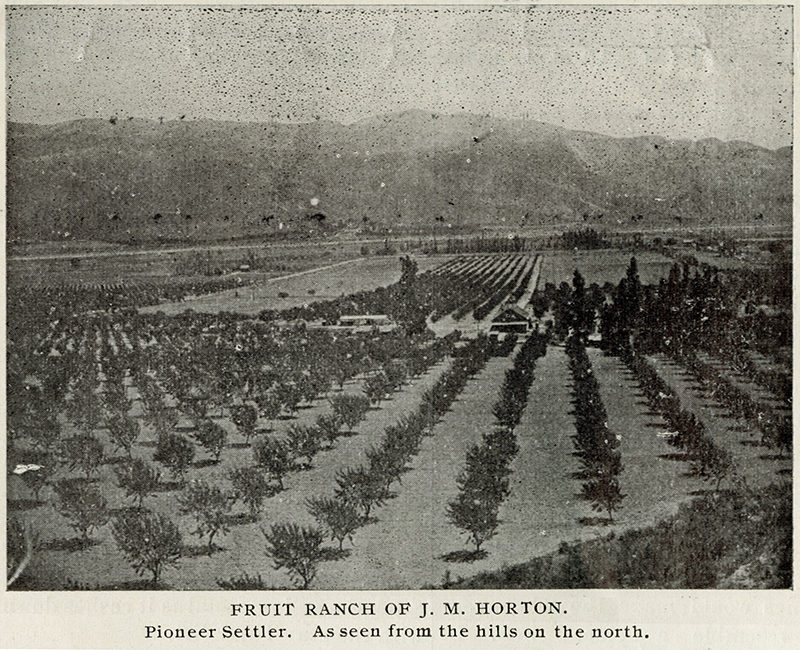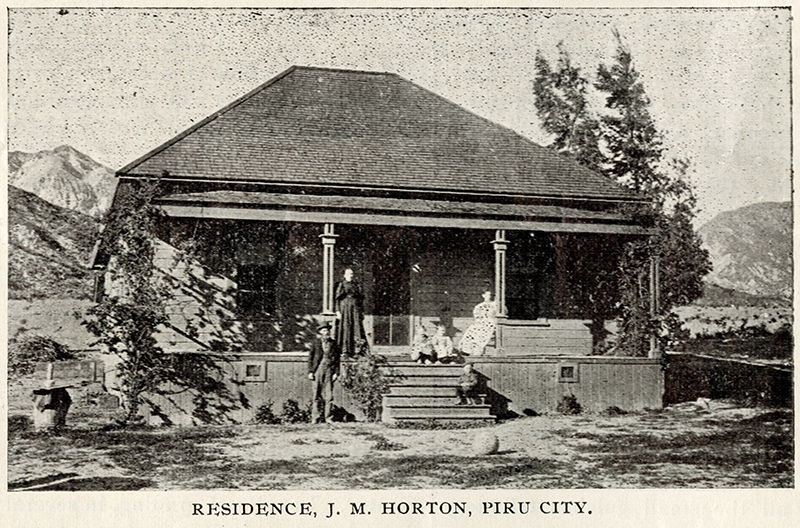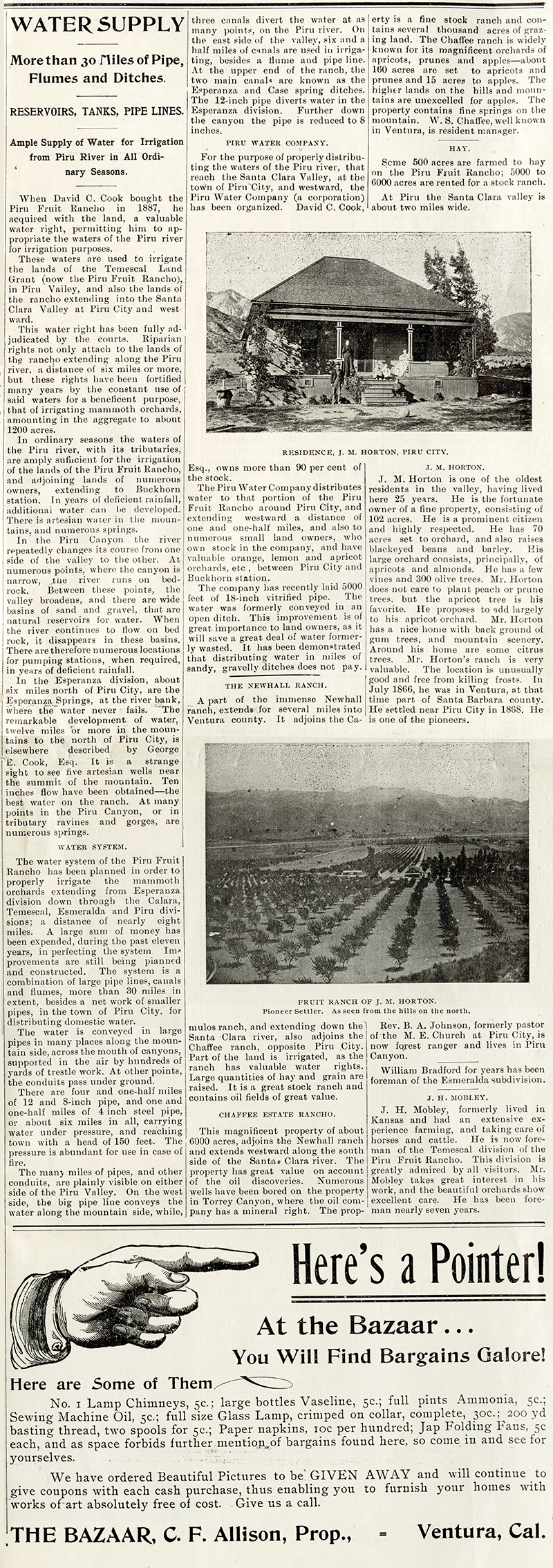
Click to enlarge.
|
Reservoirs, Tanks, Pipe Lines.
Ample Supply of Water for Irrigation from Piru River in All Ordinary Seasons.
When David C. Cook bought the Piru Fruit Rancho in 1887, he acquired with the land a valuable water right, permitting him to appropriate the waters of the Piru river for irrigation purposes.
These waters are used to irrigate the lands of the Temescal Land Grant (now the Piru Fruit Rancho) in Piru Valley, and also the lands of the rancho extending into the Santa Clara Valley at Piru City and westward.
This water right has been fully adjudicated by the courts. Riparian rights not only attach to the lands of the rancho extending along the Piru river, a distance of six miles or more, but these rights have been fortified many years by the constant use of said waters for a beneficent purpose, that of irrigating mammoth orchards, amounting in the aggregate to about 1,200 acres.
In ordinary seasons the waters of the Piru river, with its tributaries, are amply sufficient for the irrigation of the lands of the Piru Fruit Rancho and adjoining lands of numerous owners, extending to Buckhorn station. In years of deficient rainfall, additional water can be developed. There is artesian water in the mountains, and numerous springs.
In the Piru Canyon the river repeatedly changes its course from one side of the valley to the other. At numerous points, where the canyon is narrow, the river runs on bedrock. Between these points, the valley broadens, and there are wide basins of sand and gravel that are natural reservoirs for water. When the river continues to flow on bed rock, it disappears in these basins. There are therefore numerous locations for pumping stations, when required, in years of deficient rainfall.
In the Esperanza division, about six miles north of Piru City, are the Esperanza Springs, at the river bank, where the water never fails. The remarkable development of water, twelve miles or more in the mountains to the north of Piru City, is elsewhere described by George E. Cook, Esq. It is a strange sight to see five artesian wells near the summit of the mountain. Ten inches flow have been obtained — the best water on the ranch. At many points in the Piru Canyon, or in tributary ravines and gorges, are numerous springs.
The water system of the Piru Fruit Rancho has been planned in order to properly irrigate the mammoth orchards extending from Esperanza division down through the Calara, Temescal, Esmeralda and Piru divisions; a distance of nearly eight miles. A large sum of money has been expended during the past eleven years, in perfecting the system. Improvements are still being planned and constructed. The system is a combination of large pipe lines, canals and flumes, more than 30 miles in extent, besides a network of smaller pipes in the town of Piru City, for distributing domestic water.
The water is conveyed in large pipes in many places along the mountain side, across the mouth of canyons, supported in the air by hundreds of yards of trestle work. At other points, the conduits pass under ground.
There are four and one-half miles of 12 and 8-inch pipe, and one and one-half miles of 4-inch steel pipe, or about six miles in all, carrying water under pressure, and reaching town with a head of 150 feet. The pressure is abundant for use in case of fire.
The many miles of pipes and other conduits are plainly visible on either side of the Piru Valley. On the west side, the big pipe line conveys the water along the mountain side, while three canals divert the water at as many points on the Piru river. On the east side of the valley, six and a half miles of canals are used in irrigating, besides a flume and pipe line. At the upper end of the ranch, the two main canals are known as the Esperanza and Case spring ditches. The 12-inch pipe diverts water in the Esperanza division. Further down the canyon the pipe is reduced to 8 inches.
For the purpose of properly distributing the waters of the Piru river, that reach the Santa Clara Valley, at the town of Piru City, and westward, the Piru Water Company (a corporation) has been organized. David C. Cook, Esq., owns more than 90 per cent of the stock.
The Piru Water Company distributes water to that portion of the Piru Fruit Rancho around Piru City, and extending westward a distance of one and one-half miles, and also to numerous small land owners who own stock in the company and have valuable orange, lemon and apricot orchards, etc., between Piru City and Buckhorn station.
The company has recently laid 5,000 feet of 18-inch vitrified pipe. The water was formerly conveyed in an open ditch. This improvement is of great importance to land owners, as it will save a great deal of water formerly wasted. It has been demonstrated that distributing water in miles of sandy, gravelly ditches does not pay.
A part of the immense Newhall ranch extends for several miles into Ventura county. It adjoins the Camulos ranch, and extending down the Santa Clara river, also adjoins the Chaffee ranch, opposite Piru City. Part of the land is irrigated, as the ranch has valuable water rights. Large quantities of hay and grain are raised. It is a great stock ranch and contains oil fields of great value.
This magnificent property of about 6,000 acres adjoins the Newhall ranch and extends westward along the south side of the Santa Clara river. The property has great value on account of the oil discoveries. Numerous wells have been bored on the property in Torrey Canyon, where the oil company has a mineral right. The property is a fine stock ranch and contains several thousand acres of grazing land. The Chaffee ranch is widely known for its magnificent orchards of apricots, prunes and apples — about 160 acres are set to apricots and prunes and 15 acres to apples. The higher lands on the hills and mountains are unexcelled for apples. The property contains fine springs on the mountain. W.S. Chaffee, well known in Ventura, is resident manager.
Some 500 acres are farmed to hay on the Piru Fruit Rancho; 5,000 to 6,000 acres are rented for a stock ranch.
At Piru the Santa Clara valley is about two miles wide.

Click to enlarge.
|
J.M. Horton is one of the oldest residents in the valley, having lived here 25 years. He is the fortunate owner of a fine property consisting of 102 acres. He is a prominent citizen and highly respected. He has 70 acres set to orchard, and also raises blackeyed beans and barley. His large orchard consists principally of apricots and almonds. He has a few vines and 300 olive trees. Mr. Horton does not care to plant peach or prune trees, but the apricot tree is his favorite. He proposes to add largely to his apricot orchard. Mr. Horton has a nice home with back ground of gum trees and mountain scenery. Around his home are some citrus trees.
Mr. Horton's ranch is very valuable. The location is unusually good and free from killing frosts. In July 1866, he was in Ventura, at that time part of Santa Barbara county. He settled near Piru City in 1868. He is one of the pioneers.
* * *
Rev. B. A. Johnson, formerly pastor of the M.E. Church at Piru City, is now forest ranger and lives in Piru Canyon.
* * *
William Bradford for years has been foreman of the Esmeralda subdivision.
J.H. Mobley formerly lived in Kansas and had an extensive experience farming, and taking care of horses and cattle. He is now foreman of the Temescal division of the Piru Fruit Rancho. This division is greatly admired by all visitors. Mr. Mobley takes great interest in his work, and the beautiful orchards show excellent care. He has been foreman nearly seven years.

Click image to enlarge.












